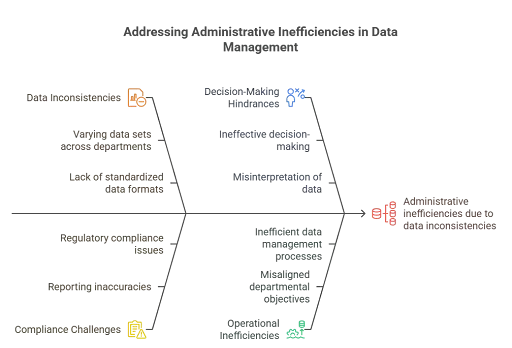In the Gulf Cooperation Council (GCC) region, higher education institutions are experiencing rapid growth and diversification. However, many universities still rely on outdated, siloed systems to manage student data. This fragmentation leads to inefficiencies, data inconsistencies, and challenges in decision-making. A recent study highlighted that many institutions in the region operate with traditional, disconnected systems—spreadsheets for enrollment, siloed databases for finance, manual attendance tracking, and fragmented reporting tools.

In Gulf universities, fragmented student data is a significant challenge that hampers operational efficiency, decision-making, and compliance. Here’s how:
Disparate systems and manual processes lead to delays, errors, and wasted time. Administrative staff often duplicate efforts, entering the same data into multiple systems, which increases the risk of inconsistencies and reduces productivity. A report from Higher Ed Dive highlights that 43% of organizations cite an increasingly distributed and remote user base as a key driver of this shift, yet struggle with integrating and standardizing insights Higher Ed Dive.
When different departments use separate systems, it becomes challenging to maintain a unified view of student information. This fragmentation leads to misaligned decision-making and poor collaboration among departments. According to SnapLogic, data silos in higher education institutions create inefficiencies and hinder decision-making.
Accurate and timely reporting is crucial for accreditation and government compliance. Fragmented data makes it difficult to generate consistent reports, risking non-compliance and potential funding issues.
The International Institute for Higher Education Research and Capacity Building (IIHEd) notes that a fragmented data infrastructure significantly constrains policy formulation, implementation, and evaluation.
Addressing these challenges requires a unified approach to student data management, ensuring efficiency, accuracy, and compliance across all departments.
A cloud-based Student Information System (SIS) is a modern digital platform that centralizes all student data—academic records, attendance, fees, grades, and more—on a secure, cloud-hosted system. Unlike traditional on-premises or siloed solutions, a cloud-based SIS allows universities to access and manage information anytime, anywhere, without relying on disconnected spreadsheets or multiple software systems. For Gulf universities struggling with fragmented student data, this technology offers a seamless, unified approach to information management.
Here’s how a cloud-based SIS addresses the core challenges:
By implementing a cloud-based Student Information System, Gulf universities can overcome data fragmentation, streamline administrative workflows, and provide a better experience for students, faculty, and leadership alike.
According to a report by Strategic Market Research, the global Student Information System market is projected to reach $16.1 billion by 2030, driven by the increasing demand for streamlined administrative processes and enhanced data security. Strategic Market Research
Read the full report here:
In the GCC region, national education digitization programs are pushing SIS adoption. Many private schools in countries like the UAE and Saudi Arabia now operate fully cloud-based SIS systems with bilingual support, reflecting a regional shift towards digital solutions. Strategic Market Research
Fragmented student data has long challenged Gulf universities, causing inefficiencies, inconsistent information, and compliance risks. Cloud-based Student Information Systems (SIS) offer a unified solution, centralizing data, enabling real-time access, and fostering collaboration across departments.
By adopting a cloud-based SIS, institutions can streamline operations, improve decision-making, and enhance the overall student experience. As higher education continues to evolve in the Gulf, embracing this digital transformation is no longer optional—it’s essential for maintaining competitiveness and achieving long-term success.
Discover how your institution can leverage digital transformation with Academia SIS. Contact us today to learn more.

Experience Academia – Your partner in transforming campus operations, a trusted all-in-one ERP/SIS solution.
Get the latest insights, trends, and updates delivered straight to your inbox!
